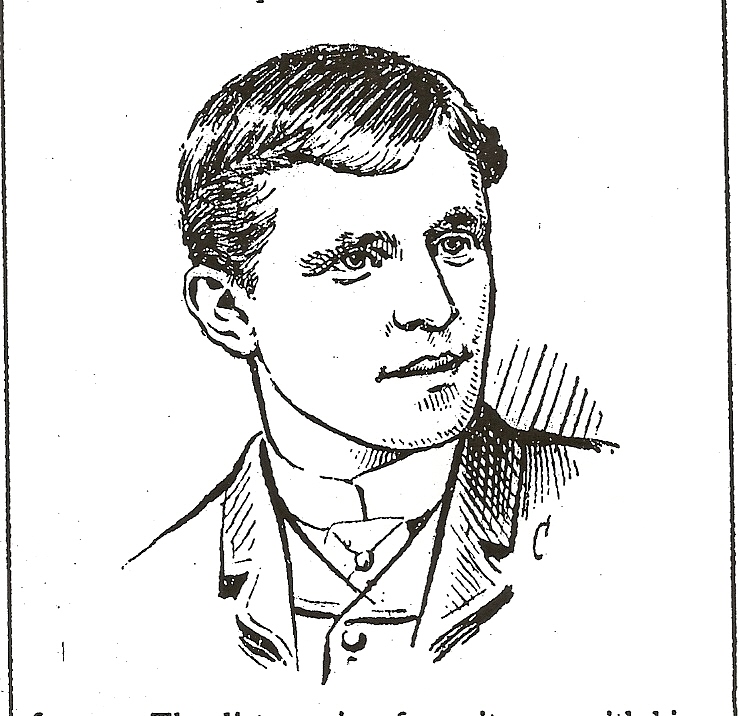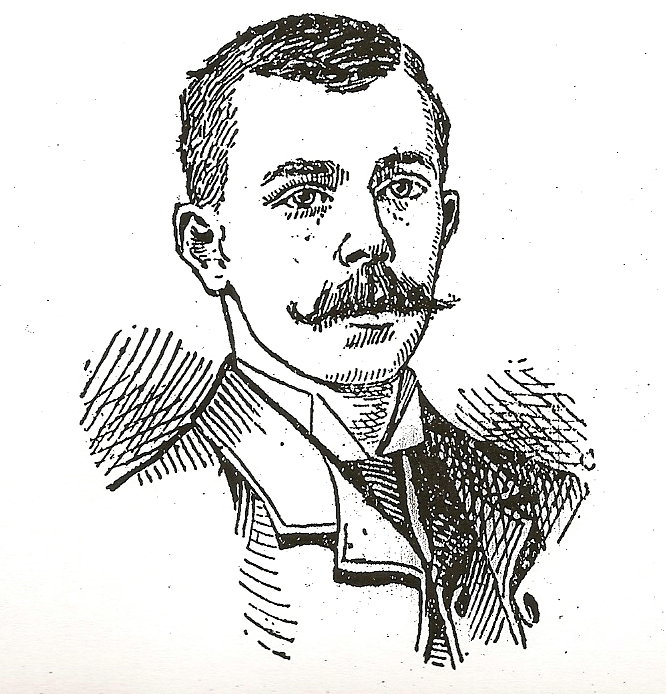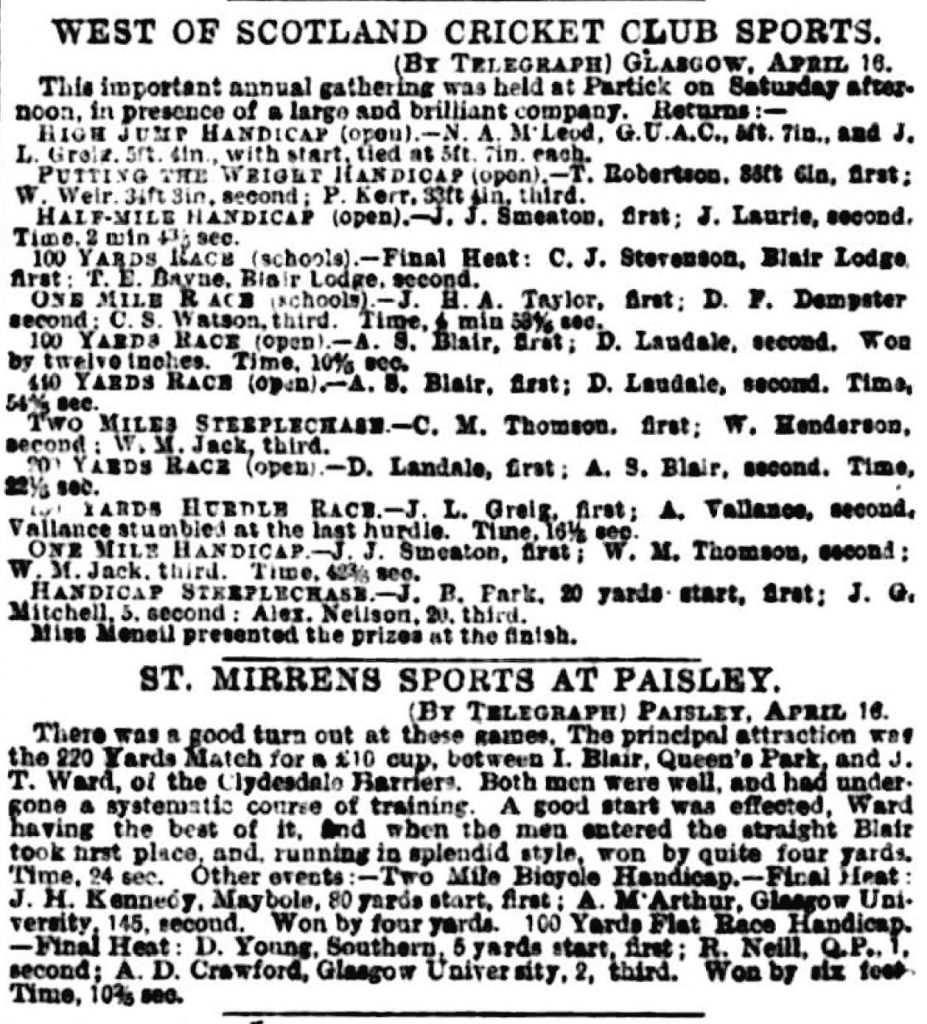This profile is of a sprinter and not a distance runner which makes it unusual on this site but it is included because of the circumstances of a particular race. I had originally written it as one of a series of Clydesdale Harriers profiles and Ward is undoubtedly a man of his time. The race in question is a challenge race for a trophy specially commissioned and presented to the winner.
With a club as notable and as long lived as Clydesdale Harriers, the difficulty in any such work as this the question is who to include and who to leave out. Many champions, international representatives and hard working club men have been omitted. GT Ward had a very successful athletics career but has been included because in 1887 he was involved in a challenge match which represents an aspect of the sport that has long disappeared. When Clydesdale Harriers was formed one of the main athletics talking points for some time had been the challenge matches between WG George and J Cummings in England. Where their three challenge events covered three races at different distances, the GT Ward and T Blair match was a one race shoot out.
GT Ward was a founder member of the club who ran in the club’s first track race – a 300 yards handicap race at Meadowside. He came from the Parkhead area of Glasgow and his father had been an Army sprinter who won several races ‘open to the entire forces.’ His sons were reported to have inherited his ability and George who was the younger first raced in 1883 in the West of Scotland Sports where he was third in the 440 yards to AS Blair and followed this up with second in the 220 yards at the Vale of Leven Sports to Peter Logan. His best meeting that year was at the Abercorn Sports in Paisley where he was first in the 100 yards, first in the 440 yards and second in the 220 yards. He was clearly a runner of some ability when he was challenged by to a race over 220 yards by T. Blair of Queen’s Park FC.
The first blast of the trumpet was an article in the ‘Scottish Umpire’ at the end of September 1886. “We hear that T. Blair (Queen’s Park FC) is anxious to meet G.T. Ward (Clydesdale Harriers) in a 220 yards race, the Harrier to get 4 yards. If the start is authentic and Ward in form the issue should not be in doubt.”
Nothing more appeared in print until the 30th November of the same year when the ‘Scottish Umpire’ had this piece: “G.T. Ward (C.H.) thinks T. Blair (Q.P.) was only joking when he said he would give him 4 yards in 220, but if he really means it, he will accept his generous allowance or run level.”
The New Year came in and then things started to get serious. In the ‘Umpire’ of 18th January 1887 – “Some time ago we made reference to the probability of a 220 yards race being arranged between T. Blair (Q.P.) and G.T. Ward (C.H.). We are now in a position to state that the race has been finally fixed. Both gentlemen, with their friends, met in our office last Wednesday to draft conditions and suggest officials. The match will probably take place at the St Mirren F.C. Sports on 15th April.”
In the ‘Scots Umpire’ of 13th April it was announced that a £10 cup had been donated for the race which was billed as the star attraction at the St. Mirren F.C. Sports in and advertisement further through the same paper. A copy of the article is attached but the gist was as follows: “What promises to be a very interesting and busy athletics season in the West opens on Saturday when the St Mirren and West Of Scotland CC Sports are to be held. Regarding the latter of these we are unfortunately not in a position to say anything very definite never having been favoured with any particulars. The St Mirren Sports however are better advertised and will no doubt be better patronised by athletes. The principal item on the programme is the long talked of 220 yards scratch race between T. Blair (Queens Park) and G.T. Ward (Clydesdale Harriers) for a £10 cup. The event is the first of the kind in Scotland and originated in the desire of the friends of the two athletes to test their respective capabilities over the distance. Ever since it was announced it has created considerable speculation, widespread interest and much diversity of opinion as to the result. In some quarters G.T. Ward finds most favour. The distance is a favourite one with him and as he has, for the first time for him in his somewhat extended athletic career, put himself unreservedly in his trainer’s hands and is pleasing him in his trials it is expected that he will beat his time and win. Tom Blair on the other hand does not lack backing and his friends are confident that he will on the eventful occasion carry off the honours. We are inclined to regard the issue as a very close one and by no means certain on the one side or the other. We however expect a splendid race and a fast time and we believe there will be a large turn out to witness its decision. The St Mirren authorities are doing their best to have all the arrangements in connection with the race as complete as possible.”
The race itself was covered in the ‘Scottish Umpire’ of 19th April 1887 as follows.
“The fact that Ward reversed the result two weeks later at the Vale of Leven Sports was of little consequence – the challenge had been lost and Blair went on to a magnificent career as a sprinter. In 1886 he was second in the 440, in 1888 he won the event in 53.4 seconds; in 1889 he again won the 440, this time in 52.2 as well as taking second in the 100 yards; in 1890 he took his third 440 yards title in 52.8 and was again second in the 100 yards; in 1891 he was second in the 440; in 1892 he was down to third in the 220 but did not turn out in the 440. Three victories, two seconds in the 440 plus a second in the 100 and a third in the 220 make for a good career!”
Challenges such as that between GT Ward and T Blair were fairly common among the top men. As mentioned earlier it was at about this time for instance that WG George and J Cummings fought out their three race, two man challenges over various distances between one mile and ten miles. The challenge would be issued, the response made, seconds nominated, terms agreed and the match made. It seems strange to us in the twenty first century that athletes would put themselves on the line like this when so many of the top men (and women) avoid each other as much as possible, preferring to achieve qualifying times in Europe, America, England and not at home against each other. It might do more to improve recruitment and standards were the practice of man to man racing reinstituted. His favourite distance was said to be 100 yards and he would have been clear favourite to take the SAAA Championship title in 1888 had his ankle not been injured and giving him considerable difficulty. Although he won three races that year, the title was not one of them. “The Scottish Umpire” reported in 1890 that he had been very unfortunate due to accidents. Presumably ‘accidents’ = ‘injuries’.
The same report went on to point out that he had won over 80 prizes ‘yet he is modest and wears no trinkets.’ It was the fashion to wear medals on the watch chain across the chest and presumably he shunned the practice. It concluded ‘He recommends himself to you by his looks which are free and winsome, set off by the fairest of fair locks.’


